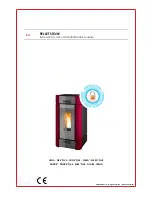
Page 22
7034-106E
September 1, 2008
R
Mt. Vernon Pellet Stove (AE)
8
Operating Instructions
A. Fuel Size, Material and Storage
1. Wood Pellets
Wood pellets are made from sawdust or wood by-products. If
the source material is hardwood, they can have a higher mineral
content, creating more ash. Fuels containing bark will also have
higher ash content.
Minerals and other non-combustible materials such as sand
will turn into a hard, glass-like substance called a clinker when
heated to the extreme temperatures our firepot reaches. This
is what forms clinkers in the bottom of the firepot. Trees from
different areas will vary in mineral content. That is why some
fuels produce more clinkers than others.
Pellets are manufactured in either 1/4 inch or 5/16 inch (6-8mm)
diameter and should be
no more than 1-1/2 inches (38mm)
in length
. Pellet lengths may even vary by lot from the same
manufacturer which is why the feed rate may need to be adjusted
occasionally.
If you burn pellets longer than 1-1/2 inches
(38mm) you may have an inconsistent fuel feed rate and/or
missed ignitions.
Pellet fuel quality can greatly fluctuate. The Advanced Energy
(AE) appliance has been designed to burn a wide variety of fuels,
giving you the choice to use the fuel that is most economical in
your region. Premium wood pellets have the lowest ash content,
under 1%. Standard grade pellet, high ash pellets, corn and
other biomass fuels all have higher ash content.
The higher the ash content, the more often the ash pan will need
to be emptied. Premium wood pellets will produce the least ash
and tends to produce the highest heat output.
Pellets made from hardwoods (i.e. oak) have a higher ash content
than pellets made from softwoods (i.e. pine). The hardwood
pellets may require more air to burn properly so make sure you
have the wall control on the correct setting.
If you are burning a higher ash fuel and your firepot and ash pan
are filling quickly, set the wall control on “Utility Pellet” and the
auto-clean system will empty the firepot more frequently.
Always burn dry fuel. Burning fuel with high moisture content
takes heat from the fuel and tends to cool the appliance,
robbing heat from your home. Damp pellet fuel can clog the
feed system.
We recommend that you buy fuel in multi-ton lots whenever
possible. However, we do recommend trying various brands
before purchasing multi-ton lots to ensure your satisfaction.
Tested and approved for wood pellets, shelled field
corn, wheat and black oil sunflower seeds. Burning
of any other type of fuel voids your warranty.
CAUTION
2. Other Fuels
This appliance has been tested and approved by Hearth &
Home Technologies for shelled field corn, wheat and black
oil sunflower seeds.
When purchasing corn or wheat to burn in your appliance,
read the ingredient label very carefully.
Do NOT purchase
fuel that contains any additives
such as oils (i.e. soybean
oil) and meals as it will result in poor unit performance.
If
you are buying corn or wheat the only ingredient that should
be listed is corn or wheat.
Shelled field corn must be 15% or less moisture content. The
corn must be clean and free from debris. Never burn corn
straight from the field. Stalk parts, excessive fines and cob
remnants, etc. will clog the auger mechanism. Corn with
excessive grain dust must be screened by sifting with 3/16
inch mesh screening.
Do not burn treated seed corn in your appliance. Seed corn
is treated with chemical pesticides that are harmful or fatal if
swallowed; therefore, seed corn is dangerous to have in the
house, expecially where children can reach it. Burning treated
seed corn in your appliane will void your warranty and will
destroy the exhaust system on the unit.
When changing to a different fuel, be sure to empty the hopper
of the previous fuel and vacuum the hopper before you fill it
with the new fuel. Make the appropriate selection on the FUEL
SELECTION screen on the thermostat wall control. The burn
rate, BTU content and heat output will all vary depending on
fuel selected.
See Figure 23.3 on page 23.
3. Storage
Wood pellets should be left in their original sealed bag until
using. This will prevent moisture absorption.
Shelled corn, wheat or sunflower seeds should be stored in
a tight container where it will not absorb moisture from damp
or wet floors. This will also prevent rodents from becoming
a problem.
Do not store any pellet fuel within the clearance requirements
or in an area that would hinder routine cleaning and
maintenance.
Risk of Chemical Poisoning.
• Do Not burn treated seed corn
• Chemical pesticides are harmful or fatal if
swallowed
• Burning treated seed corn will void your
warranty
WARNING
















































